A new variety that has already managed to fall in love with farmers - the tomato "Sugar Nastasya"
Many varieties of tomatoes are difficult to distinguish from each other, as they are similar in taste and appearance. Just not the variety Sugar Nastasya, which, despite its youth, has won the attention of numerous fans with its excellent taste and unusual shape, harmoniously combined with a deep scarlet color.
The culture is grown with pleasure in all regions, enjoying the sweetness of a vegetable with an original fruit flavor.
The content of the article
Characteristics and description of the variety
Tomato Sugar Nastasya from "Gavrish", a selection and seed-growing company, was included in the State Register in 2015. Recommended for breeding in any regions of the Russian Federation in open ground and greenhouse conditions.
reference! Gavrish is one of the leading Russian companies in the creation of high quality seeds.
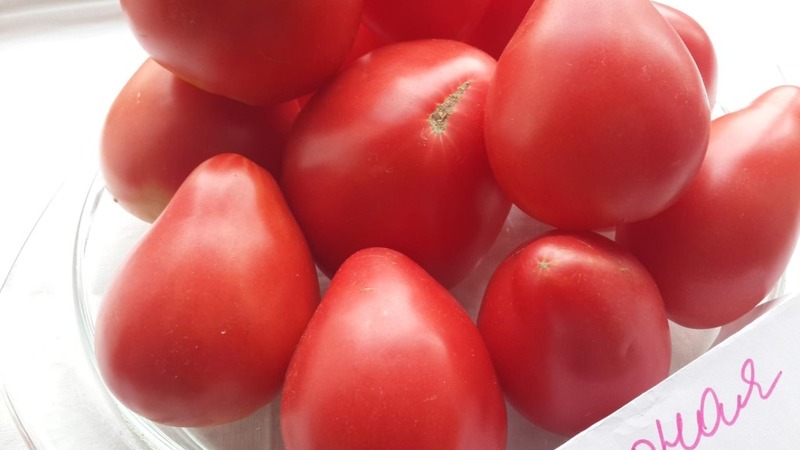
Distinctive features
Bush indeterminate, height - 1.5–1.7 m. Leafiness is moderate, leaves are medium, dark green in color. The inflorescences are simple, the stem is powerful. Fruit-bearing branches are located throughout the trunk, each tying 8-9 fruits. Requires compulsory pinching, formation and garters.
The variety belongs to the late-ripening varieties: from the moment of sowing to full maturation, 120-130 days pass.
Productivity is high: up to 15 kg of fruits are harvested from 1 m2, planting 3-4 seedlings per 1 m2.
The tomato has strong immunity to diseases such as late blight, brown spot and fusarium leaf wilting.
Fruit characteristics
The weight of ripe tomatoes reaches 400 g, the shape resembles a heart, the color is pink-scarlet. The taste is sweet due to the high sugar content, without sourness. The pulp is juicy, few seeds. The peel is thin, delicate, so tomatoes do not withstand long-term storage and transportation.
A variety exclusively for salad purposes, suitable for preparing any fresh dishes. Ripe vegetables are used for processing, getting excellent juices, ketchups and sauces, but fruits are not suitable for whole-fruit canning.
The photo shows the tomatoes Sugar Nastasya.
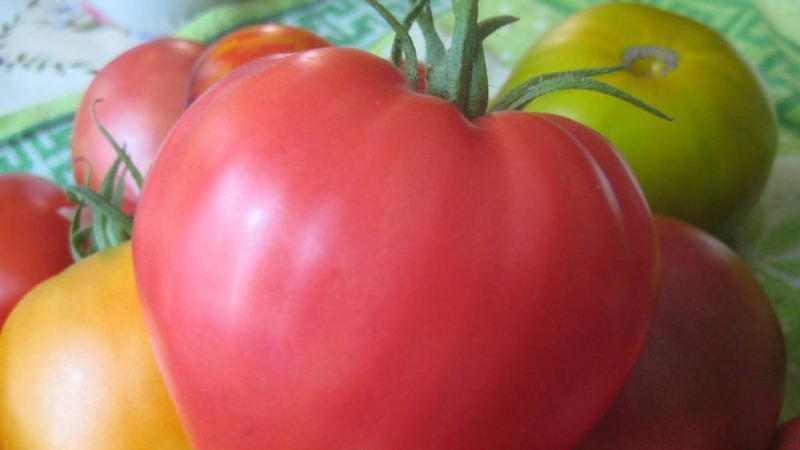
How to grow seedlings
Seeds for seedlings are sown at the beginning of March or at the end of February, 2 months before planting in the ground. Overgrown seedlings do not take root well when transplanted to a permanent place.
Seed preparation
Since the culture is not hybrid, seeds for planting can be prepared independently by selecting them from the largest fruits. However, such inoculum needs careful disinfection.
First, the grains are inspected for visible damage, and then they are checked for filling inside. To do this, the seeds are kept for 10 minutes in a saline solution (1 teaspoon of salt in a glass of warm water). Those that have surfaced are unsuitable for landing, since they are empty inside.
Disinfection of seed is carried out in a weak solution of potassium permanganate. Dissolving 1 g of potassium permanganate in 1/2 tbsp. water, the seeds are placed in the solution for 20 minutes. After disinfection, they are washed with running water and dried.
To improve germination, the grains are soaked for 10 hours in a growth stimulator. After the seeds are swollen, they are planted in the ground.
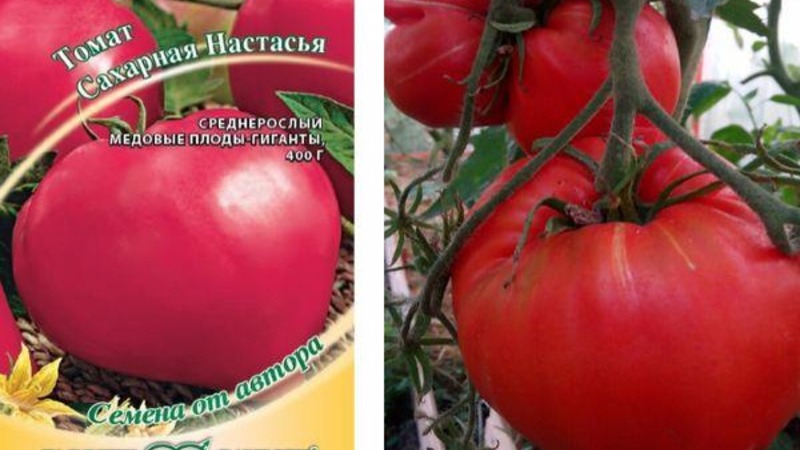
reference! From specialized stimulants use "Zircon", "Epin" or "Kornevin".
Capacity and soil
The soil for seedlings is prepared nutritious and fertile. Sod land is mixed with humus in equal amounts and sawdust or washed river sand is added for ease. Add 1 tbsp to the mixture. spoon of wood ash and mix again.
The soil is spilled with a hot solution of dark manganese for disinfection. After the soil has cooled, it is laid out in planting containers.
It can be planted in a common wooden box and in separate containers (for example, plastic cups, peat pots). When planting in plastic containers, small holes are made at the bottom for drainage. Otherwise, the accumulation of excess moisture will lead to the spread of the blackleg fungal disease.
reference! Blackleg is a collective name for diseases with similar symptoms. The lower part of the stem darkens and narrows, the plant's metabolism is disturbed, as a result it dies due to lack of nutrition. Pathogens are the simplest fungi and bacteria that affect the root zone of plants. The disease can destroy all plantings.
Planting containers must be treated in a solution of potassium permanganate, thereby reducing the risk of developing infections.
Sowing
Seeds are laid in grooves to a depth of 1 cm, sprinkled with soil on top and slightly compacted. Moisten the earth from a spray bottle with warm, settled water and cover the containers with a film to create greenhouse conditions. Until emergence, containers are left in a warm room at a temperature of at least +24 ° C.
reference! When planted shallowly, the seeds germinate with the shell, which slows down their further growth.
Seedling care
When shoots appear, the containers are rearranged on the windowsill. For full development, daylight hours should be at least 12 hours. Additional illumination can make up for the lack of receiving sunlight.
Water the seedlings with warm, settled water along the edge of the nursery. It is impossible to fill in the sprouts, as excessive moisture will negatively affect the young roots.
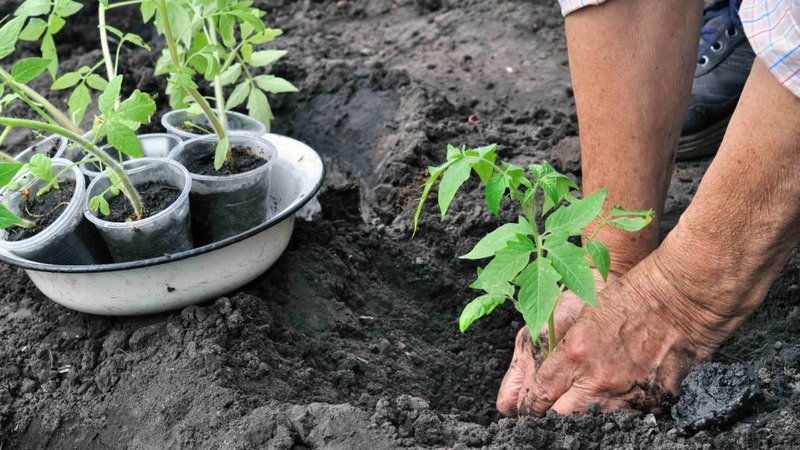
After watering, the soil is loosened with a wooden stick or an ordinary fork.
When 1-2 true leaves appear, the seedlings are dived, seated in separate containers. Many gardeners shorten the main root by one third. After that, lateral roots are intensively grown and young plants develop more intensively. When grown in peat tanks, picking is not required.
2 weeks before transplanting, the seedlings are hardened in the open air. To do this, they are taken out into the street for 1 hour, gradually increasing the time to 10 hours.
reference! The hardening procedure strengthens the immunity of young plants.
How to grow tomatoes
In early May, the seedlings are sent to the greenhouse. At the end of May, landing under film shelters is possible, and in open ground - not earlier than June.
Landing
They are planted according to the scheme: 40 cm - distance between seedlings, 60 cm - distance between rows. No more than 4 plants are placed per 1 m2.
Wells are prepared in advance, a little ash or sawdust is placed on the bottom of each. The seedlings are buried to the first leaves, watered with warm, settled water and left to get used to new conditions for 1 week.
Further care
Regularly watered as young bushes take root. It is not recommended to overmoisten the beds - this is fraught with the occurrence of rot. Optimal watering - 2 times a week, at least 3 liters for each plant. To keep the beds moist longer, they are mulched.
After watering, the soil is loosened, improving oxygen access to the roots. Removing weeds is necessary to reduce the risk of fungal diseases. In addition, weeds draw out many useful substances from the soil.
reference! This herb is used as mulch. When rotting, it supplies the root system of the vegetable crop with additional nutrients.
The first top dressing make 2 weeks after transplantation. Fertilized with a full range of minerals.The second feeding is applied at the time of the formation of ovaries. Here, an aqueous infusion of mullein is used in a ratio of 1:10. For the third time, the plants are fed at the time of fruiting with a full complex of minerals with the addition of potassium salts.
Features in care and possible difficulties
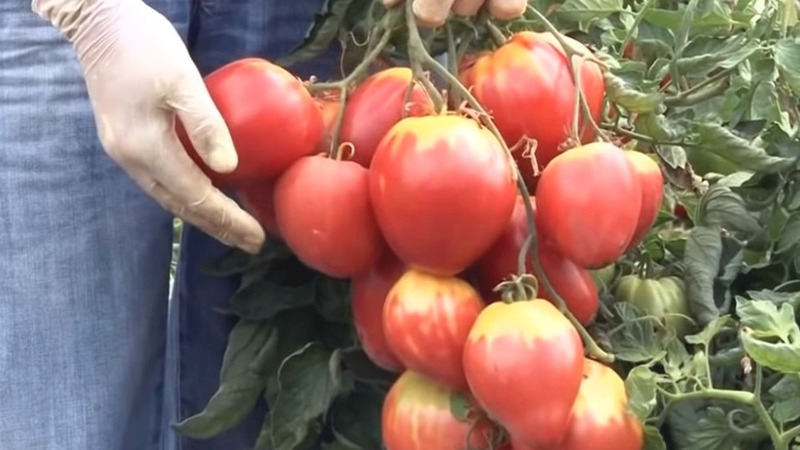
Culture needs compulsory formation. The bush is led in 1 stem, otherwise the yield will noticeably decrease, and the fruits will be smaller. No more than 6 fruiting brushes are left on the stem, each of which has no more than 5 ovaries. With this care, fruiting will delight you with larger and more juicy vegetables.
Stepsons removed regularly to prevent thickening of the plantings. The procedure is carried out in the morning, so that all wounds have time to heal by the evening. For faster healing, the sections are sprinkled with wood ash.
During transplantation, a wooden or metal support is installed next to each bush. The stem is fixed almost immediately during transplantation so that it forms even and strong. As it develops, fruitful branches are also tied to the support, since they will not withstand the weight of ripe fruits.
Diseases and pests
Tomato is highly resistant to diseases such as late blight, brown spot and fusarium. However, in order to prevent it, it is necessary to carefully examine each seedling in order to notice any changes in time. In addition, plant inspection prevents the spread of pests.
In addition, preventive methods include:
- moderate watering and moisture control;
- removal of weeds with roots;
- loosening and mulching;
- airing the greenhouse.
When transplanting, the seedlings are sprayed with a solution of pink manganese, and the earth is spilled with copper sulfate.
If, nevertheless, the plants are struck by a fungus, fungicidal agents (for example, "Fitosporin") are used for treatment. Seedlings are treated with the same remedy for preventive purposes.
The most dangerous pests are whiteflies and aphids.... Aphids are removed by treating the stems with soapy water. It is prepared from 1 piece of laundry soap dissolved in a bucket of water.
In the fight against whitefly, pheromone traps are used and pungent-smelling herbs are planted next to the tomato, which scare off the pest with their smell. Such plants include basil, arrows of onions and garlic, mustard bushes. In case of a large accumulation of whiteflies, the Confidor insecticide is used.
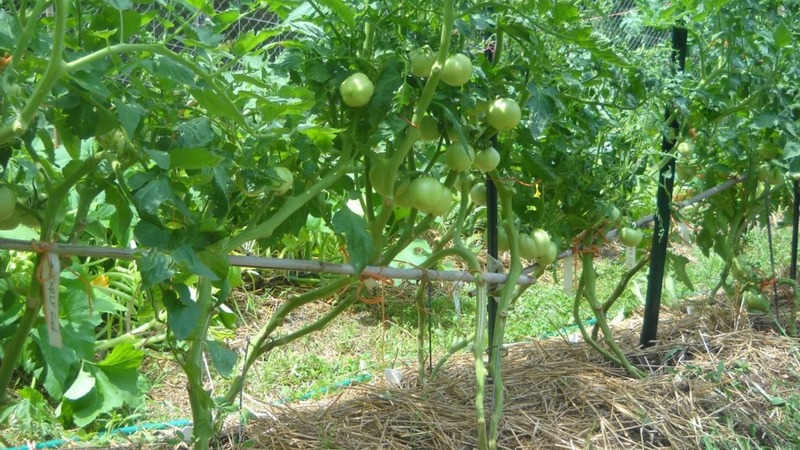
Nuances when growing in a greenhouse and in the open field
The height of greenhouse plants exceeds the growth of street seedlings and reaches 1.7-1.8 m. To limit growth, pinch the crown of the plant, thereby stopping the growth and development of unnecessary branches. In the open field, this is done at the beginning of fruiting, so that all forces go to ripen the fruits.
To increase the quantitative indicator, artificial pollination is used. This technique is most effective when breeding crops in greenhouse conditions.
According to the rules of crop rotation, the tomato is not planted in those beds where potatoes, eggplant or peppers previously grew. These crops also belong to the nightshade family and, as they develop, draw out nutrients from the ground, depleting the soil. When planted in such soil, the tomato will suffer from a lack of nutrients. Therefore, the soil is either saturated with fertilizers, or tomatoes are planted in other beds.
Planting a vegetable next to potatoes is not recommended, since they are affected by the same diseases and pests. Potatoes are considered a carrier of infections, so neighboring crops most often suffer from it.
Harvesting and application of the crop
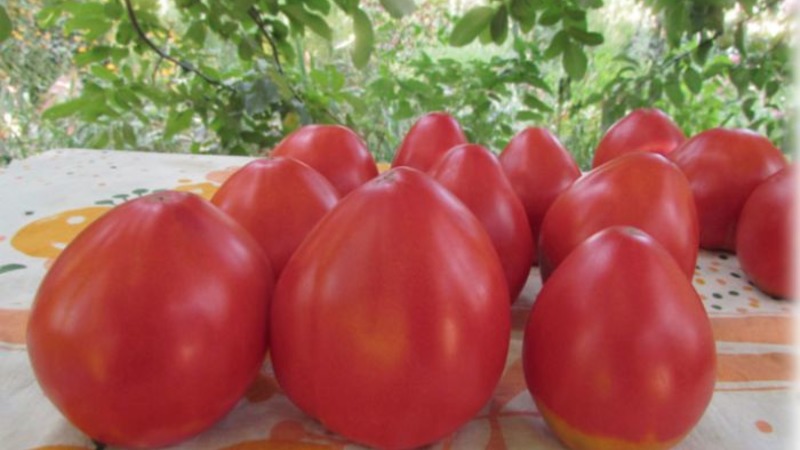
Harvesting begins in late July or early August. Since the variety belongs to salad dressing, it is recommended to use it in any fresh dishes. Tomatoes are cut into fresh salads, various snacks, pizza and sandwiches. Excellent freshly squeezed sweet juices are obtained from vegetables.
Sugar Nastasya tomatoes are also used for the preparation of canned products: juices, ketchups, lecho and adjika.
Long-term storage of ripe vegetables is impossible, so they are consumed immediately after harvesting, or they are processed for winter harvesting.
Advantages and disadvantages of the variety
Culture has many positive qualities:
- the possibility of breeding in all regions;
- high rate of fruiting;
- unpretentious care;
- resistance to diseases of the tomato series;
- the formation of numerous ovaries;
- excellent sweet taste;
- large fruits;
- unusual shape;
- the possibility of self-collecting seeds for planting.
Negative properties include:
- obligatory garter;
- the need for formation and pinching;
- short storage;
- impossibility of transportation.
Farmers reviews

The fruits of the tomato are so beautiful when ripe that many gardeners plant the variety on their plots after seeing the photos. Taste characteristics are as impressive as the appearance of ripe vegetables:
Olga, Syzran: “I really like large tomatoes so that they can cook fresh salads. I call my favorite variety just like tomato Sugar Nastya. Tomatoes are really sugar and very aromatic. I keep cutting off the extra leaves, so my seedlings do not get sick. "
Eugene, Ryazan: “I am a summer resident with experience, I have tried many varieties. Now it's Sugar Nastenka's turn. I have a large garden, so the size of the bushes is not scary. Tomatoes grew very beautiful: large, pink, sweet. But for this you need to regularly feed and water. However, like any other culture. "
Conclusion
The Sugar Nastasya variety, which has recently added to the tomato rows, has become an indispensable crop for many gardeners on the plots. This is due to simple agricultural technology, resistance to the main dangerous diseases (late blight, brown spot, fusarium) and a high quantitative yield indicator (from 1 m2 to 15 kg of excellent fruits).
Sweet, large and unusual tomatoes appear on tables more and more often not only in fresh salads, but also in winter preparations.